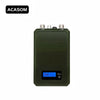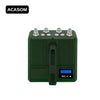How do GaN Chips Work in Drone Signal Jammers?
Drone technology has rapidly advanced in recent years, bringing both innovative benefits and new security challenges. The rise of drones has prompted a need for effective countermeasures, with drone signal jammers playing a vital role in preventing unauthorized drones from accessing sensitive airspace. In this article, we will explore how Gallium Nitride (GaN) chips are enhancing the performance of these signal jammers, providing a powerful solution for neutralizing drone communication signals.
Overview of Drone Signal Jammers
With drones becoming more prevalent in industries ranging from military and defense to security and logistics, the need for reliable counter-drone technology has increased. Drone signal jammers disrupt the communication between a drone and its controller, causing the drone to lose connection and land safely or return to its home point. These jammers are particularly useful for preventing unauthorized drones from intruding into restricted airspace, such as near airports, military bases, or public events.
Signal jammers rely on advanced electronic components, including RF (Radio Frequency) amplifiers and power management systems. Gallium Nitride (GaN) chips have become the preferred material in these systems due to their exceptional performance. In the following sections, we will delve into how GaN technology works in drone signal jammers, the advantages it brings, and its key role in enhancing jammer performance.
1. What is GaN Technology?
Definition of Gallium Nitride (GaN)
Gallium Nitride (GaN) is a wide-bandgap semiconductor material that is used in a range of applications, including power electronics, RF devices, and optical devices. Unlike traditional silicon semiconductors, GaN offers superior performance in high-power and high-frequency environments. This makes GaN an ideal material for RF components in drone signal jammers, where power handling and signal fidelity are critical.
GaN vs. Traditional Silicon (Si) Semiconductors in RF Applications
In RF applications, GaN outperforms traditional silicon (Si) semiconductors in several key areas:
-
Higher efficiency: GaN chips deliver more power with less energy loss compared to silicon.
-
Thermal performance: GaN can operate at higher temperatures, making it more suitable for high-power jamming applications.
-
Frequency handling: GaN is able to handle much higher frequencies, which is crucial for targeting a broad spectrum of drone communication signals.
These advantages make GaN the go-to material for modern RF components used in drone jammers.
2. The Science Behind GaN Chips in Signal Jammers
Principle of Operation of Signal Jammers
Signal jammers work by emitting radio frequency signals that interfere with a drone's communication and control signals. The jammer targets specific frequencies, such as those used by GPS, WiFi, and cellular networks, to disrupt the drone's ability to communicate with its operator. Jammers use RF power amplifiers to boost their signal strength, and GaN chips are the critical components that make these amplifiers efficient.
GaN Chips in RF Power Amplifiers
GaN chips are used in RF power amplifiers to increase the output power of the jammer. These amplifiers take low-power input signals and amplify them to a level that can effectively interfere with drone communication. GaN’s superior properties enable the amplifier to:
-
Deliver high output power without significant signal degradation.
-
Achieve high linearity, meaning the amplified signal remains clean and distortion-free.
-
Reduce thermal buildup, preventing overheating during prolonged jamming operations.
By leveraging GaN’s exceptional capabilities, signal jammers can deliver more powerful, reliable, and efficient jamming performance.
3. Key Advantages of GaN Chips in Drone Signal Jammers
High Efficiency and Low Power Consumption
One of the standout features of GaN chips is their energy efficiency. GaN chips convert a higher percentage of electrical energy into useful RF output power while minimizing energy losses. This efficiency is particularly important for battery-operated jammers, where extended operational life is crucial. Drone signal jammers powered by GaN chips can operate for longer periods without requiring frequent recharges or power replenishment.
Wide Frequency Range
GaN chips excel in handling a wide frequency range, making them perfect for disrupting multiple types of drone communication signals. Whether it's GPS signals for navigation, WiFi for real-time communication, or 4G/5G cellular signals for data transfer, GaN-powered jammers can target these frequencies simultaneously. This capability allows for comprehensive protection against a variety of drone models that use different communication protocols.
Improved Heat Dissipation and Durability
High-power jammers generate significant heat, which can damage electronic components if not properly managed. GaN chips have exceptional thermal conductivity, which means they can dissipate heat more effectively than traditional semiconductors like silicon. This prevents overheating and ensures that the jammer remains operational for extended periods without performance degradation, enhancing reliability and durability in the field.
Enhanced Power Handling Capabilities
GaN chips can handle high power levels without compromising their efficiency or longevity. This makes them well-suited for military and commercial counter-drone applications, where high-power jamming is needed to disrupt communication at long ranges. The ability to handle higher power also ensures that the jammer can neutralize drones operating at greater distances or in more challenging environments.

4. GaN vs. Traditional Semiconductor Chips in Jamming Applications
Silicon-Based vs. Gallium Nitride-Based Power Amplifiers
When comparing silicon-based to GaN-based RF power amplifiers, the latter clearly outperforms the former:
-
Linearity: GaN chips offer better linearity, meaning they can amplify signals without distorting them, which is essential for effective jamming.
-
Efficiency: GaN amplifiers operate with less energy loss, making them more power-efficient and less prone to overheating.
-
Frequency Handling: GaN’s ability to operate at higher frequencies allows jammers to target more communication channels used by drones.
Overall, GaN’s superior performance in power handling, frequency range, and efficiency makes it the preferred choice for modern jamming systems.
Cost vs. Performance
While GaN chips come with a higher upfront cost than silicon-based alternatives, their long-term value is undeniable. The performance improvements—such as better efficiency, power handling, and thermal management—translate into lower operational costs and higher reliability over time, especially for industries like military and security, where jammers are relied upon in high-stakes environments.
5. Applications of GaN-Powered Drone Signal Jammers
Military and Defense
In military settings, counter-drone systems powered by GaN chips are crucial for neutralizing hostile drones. GaN technology allows for long-range jamming, targeting both GPS signals and drone control signals to take down enemy drones before they can pose a threat.
Commercial and Security
In the commercial sector, airports, critical infrastructure, and public events use GaN-powered jammers to prevent unauthorized drones from entering restricted airspace. These jammers help protect sensitive locations from potential surveillance or attacks by drones.
Emerging Trends
As drone technology evolves, so too do countermeasures. The integration of artificial intelligence (AI) with GaN-based jammers is one such trend. AI can enable adaptive jamming, where the jammer automatically adjusts its frequency range to target specific drone communications in real-time. This makes GaN-powered jammers even more effective in countering sophisticated drones.
6. Challenges and Considerations for Using GaN in Drone Signal Jammers
Heat Management and System Design
While GaN chips excel in heat dissipation, high-power systems still require efficient cooling solutions. The design and integration of GaN-powered jammers must ensure proper thermal management to maintain performance during long periods of operation.
Regulatory Considerations
The use of signal jammers is highly regulated in many countries due to the potential for interference with other RF communications. Compliance with legal and ethical standards is crucial for manufacturers and operators of drone signal jammers, especially in regions with stringent RF interference laws.
Cost and Availability of GaN Components
The higher initial cost of GaN chips and their availability can impact the development and scaling of commercial drone jammers. However, as GaN technology becomes more widespread, these challenges are likely to diminish, making GaN-powered jammers more affordable and accessible.
7. Conclusion: The Future of GaN in Drone Signal Jammers
GaN technology offers a host of benefits for drone signal jammers, including higher efficiency, superior power handling, and expanded frequency coverage. As drone threats continue to evolve, the adoption of GaN-powered jammers will remain a critical component of counter-drone systems.
Looking ahead, the continued evolution of GaN chips will drive advancements in drone defense technology, including integration with 5G, IoT, and AI-based systems for even more effective jamming solutions.
Call to Action
Stay informed about the latest advancements in GaN technology and explore the most effective drone signal jammers on the market. Investing in GaN-powered jammers ensures optimal performance and reliability in protecting your airspace from unauthorized drone activity.





